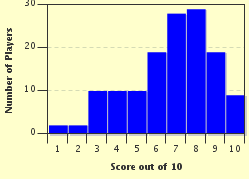Quiz Answer Key and Fun Facts
1. In what country might the school lunch consist of rice and a flavored cabbage called kimchi?
2. In a typical school lunch in France a student might find cucumbers with garlic and herbs; baked chicken thigh with red and green bell peppers, herbs and olive oil, yogurt, an apple and this traditional steamed North African pasta dish?
3. Famously in the 1980s the US government proposed to classify what tomato based condiment as a vegetable when considering school lunches?
4. Providing a healthy school lunch is an essential part of the Japanese educational system. What percentage of primary education students receive a free lunch in Japan?
5. In Sweden school lunches commonly include potatoes, salad, fish or meat and this indigenous and popular berry juice?
6. Despite attempts to improve the nutritional quality of US school lunches hamburgers, hot dogs and french fried potatoes remain staples of the diet along with this high in salt, fat and carbohydrates favorite made from dough, cheese, tomato sauce and frequently topped with fatty meats?
7. If it is Thursday in Finland students will likely have "hernekeitto" a traditional vegetable soup for lunch. What is the common English name for this hearty green soup?
8. A high percentage of Australian school children bring their lunches from home and most local schools outsource the provision of the canteen. As such many Australian children bring sandwiches of cheese and this salty yeast based spread in their lunch sack.
9. In Kenya school children often receive a highly nutritious lunch of githeri. Githeri is a stew made primarily from what two vegetable ingredients?
10. Surprisingly, what large affluent Western Hemisphere country does not have a national school lunch program or a tradition of school canteens or cafeterias?
Source: Author
adam36
This quiz was reviewed by FunTrivia editor
WesleyCrusher before going online.
Any errors found in FunTrivia content are routinely corrected through our feedback system.

